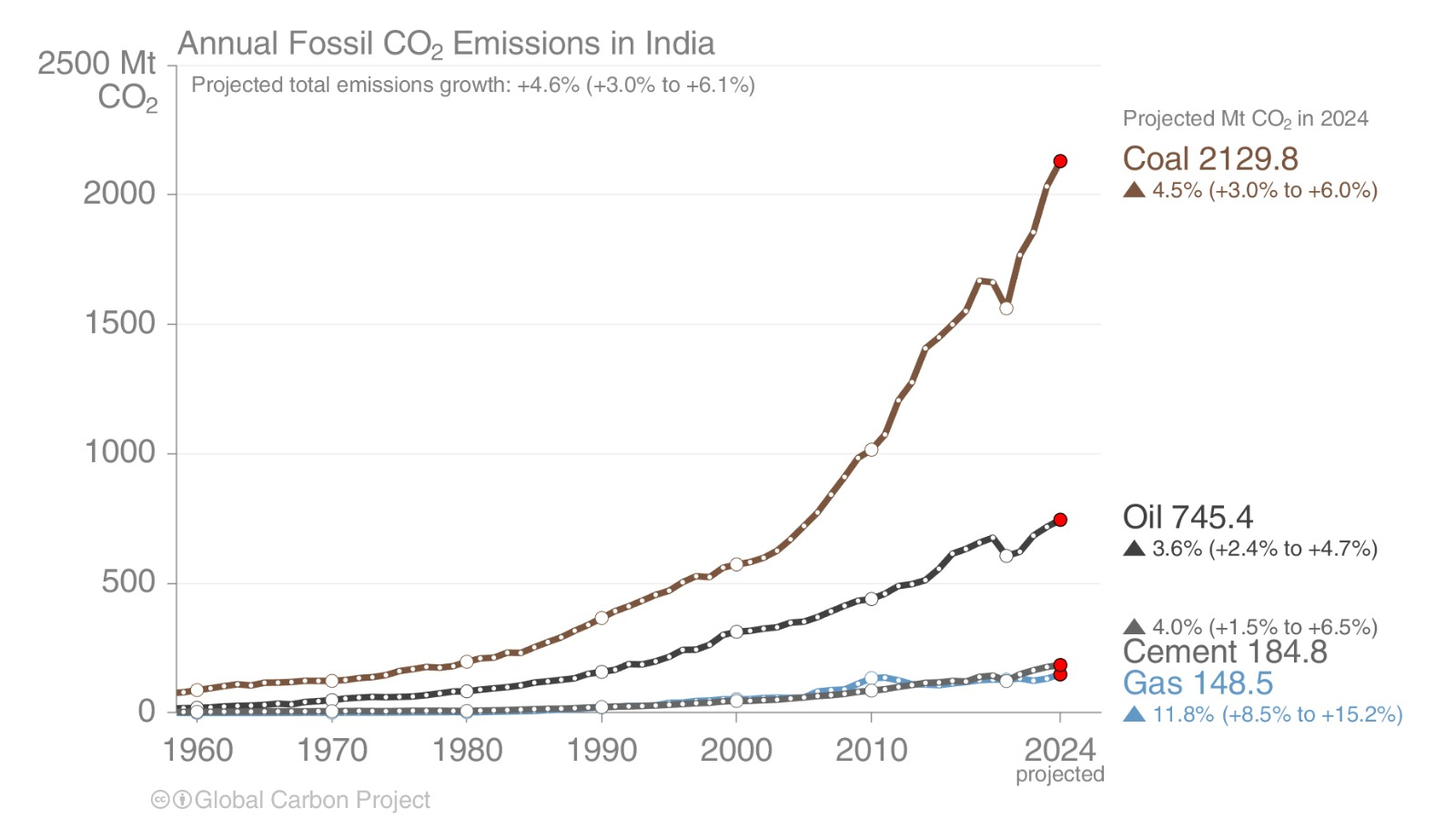- Courses
- GS Full Course 1 Year
- GS Full Course 2 Year
- GS Full Course 3 Year
- GS Full Course Till Selection
- Online Program
- GS Recorded Course
- NCERT (Recorded 500+ Hours)
- Polity Recorded Course
- Geography Recorded Course
- Economy Recorded Course
- AMAC Recorded Course
- Modern India, Post Independence & World History
- Environment Recoded Course
- Governance Recoded Course
- Science & Tech. Recoded Course
- International Relations and Internal Security Recorded Course
- Disaster Management Module Course
- Ethics Recoded Course
- Essay Recoded Course
- Current Affairs Recoded Course
- CSAT
- 5 LAYERED ARJUNA Mentorship
- Public Administration Optional
- ABOUT US
- OUR TOPPERS
- TEST SERIES
- FREE STUDY MATERIAL
- VIDEOS
- CONTACT US
India’s fossil fuel CO2 emissions set to rise 4.6% in 2024
India’s fossil fuel CO2 emissions set to rise 4.6% in 2024
15-11-2024
According to the Global Carbon Project’s study latest report presented at 29th Confrence of Parties (COP29) in Baku, Azerbaijan, India’s fossil fuel carbon dioxide (CO2) emissions are expected to rise 4.6% in 2024, the highest among major economies.
What is the Global Carbon Project (GCP)?
- Global carbon project was established in 2001 to track the trends in global carbon emissions and sinks and acts as a key measure of progress towards the goals of the Paris Agreement.
- It publishes global budgets for three dominant greenhouse gases — i) carbon dioxide, ii) methane, and iii) nitrous oxide.
- It is a collaborative research initiative with scientists from over 80 institutions worldwide, including the University of Exeter, the University of East Anglia (UEA), Ludwig-Maximilian-University Munich, Alfred-Wegener-Institute & etc. in Norway.
- The 2024 Global Carbon Budget projects fossil carbon dioxide (CO2) emissions of 37.4 billion tonnes, up 0.8% from 2023.
- With projected emissions from land-use change (such as deforestation) of 4.2 billion tonnes, total CO2 emissions are projected to be 41.6 billion tonnes in 2024, up from 40.6 billion tonnes last year.
What are the Key Highlights from the Report on the global carbon emissions?
-
India's CO₂ Emissions Growth (2024):
- Projected Increase: India's fossil fuel CO₂ emissions are set to rise by 4.6%, the highest among major economies.
- Emission Sources: Coal: Up by 4.5%, Oil: Up by 3.6%, Natural Gas: Up by 11.8% (though from a low base), Cement: Up by 4%
- Global Contribution: India contributes around 8% to global CO₂ emissions.

-
World CO₂ Emissions Growth (2024):
- Fossil Fuel Emissions: Projected increases in 2024: coal (0.2%), oil (0.9%), gas (2.4%); contributing 41%, 32%, and 21% of fossil CO₂ emissions, respectively.
- Country-Specific Emissions: China: Marginal increase (0.2%), contributing 32% of global emissions. US: Projected decrease (0.6%), 13% of global emissions. EU: Decrease of 3.8%, 7% of global emissions. Rest of the World: Increase by 1.1%, 38% of global emissions.
- International Aviation and Shipping: International aviation and shipping (3% of the global total, and counted separately from national/regional totals) are projected to increase by 7.8% in 2024, but remain below their 2019 pre-pandemic level by 3.5%.
- Carbon Sinks: In 2024, oceans absorbed about 10.5 billion tonnes of CO2. However, their efficiency has declined by 5.9% over the past decade due to climate effects, reducing the amount of CO2 they can absorb.
- Land-Use Change Emissions: emissions from land-use change (such as deforestation) have decreased by 20% in the past decade, but are set to rise in 2024.
- CO₂ Removal through Forests: Permanent CO2 removal through reforestation and afforestation (new forests) is offsetting about half of the permanent deforestation emissions.
- Technology-Based CO₂ Removal: Current levels of technology-based Carbon Dioxide Removal only account for about one-millionth of the CO2 emitted from fossil fuels.
- Atmospheric CO₂ Levels: Atmospheric CO2 levels are set to reach 422.5 parts per million in 2024, 2.8 parts per million above 2023, and 52% above pre-industrial levels.
- El Niño Effects: El Niño, a periodic climate pattern, raised global temperatures in 2023, reducing CO2 absorption by land.
- Wildfire Emissions: 2024 emissions are above the 2003–present average, driven by extreme wildfires in Canada and drought in Brazil.
- CO₂ Sinks (Land and Ocean): The land and ocean CO2 sinks combined continued to take up around half of the total CO2 emissions, despite being negatively impacted by climate change.
- Warming Threshold: Limiting global warming to 1.5ºC is a key climate target to avoid severe environmental consequences. GCP projects a 50% probability of consistently exceeding this limit within six years if emission trends continue unchecked.
What are the recommendations to Bridge the Emissions Gap?
- Low-Carbon Development: Prioritise a global shift to low-carbon pathways, focusing on transitioning energy systems; fossil fuel use must be limited to stay within carbon budgets.
- Support and Financing: High-emission, high-capacity countries should lead with ambitious actions and financial and technical aid for developing nations aiming for low-emission development.
- Carbon Dioxide Removal: Future reliance on carbon removal technologies is essential, but current technological limitations and risks require immediate and accelerated climate action.
What are the Initiatives to Reduce Emissions in India?
- Bharat Stage-IV to Bharat Stage-VI Emission Norms: India skipped BS-V and directly adopted BS-VI in 2020, reducing vehicle emissions by 80% for PM and 70% for NOx. This shift improved fuel standards, promoting cleaner vehicular technologies.
- UJALA Scheme: Launched in 2015, UJALA distributed over 36 crore LED bulbs by 2021, reducing 47 billion kWh annually and saving 38 million tonnes of CO2 emissions. This initiative enhances energy efficiency and lowers household electricity costs.
- International Solar Alliance (ISA): India co-founded the ISA in 2015, aiming to mobilise $1 trillion for solar projects by 2030. It promotes solar energy to reduce reliance on fossil fuels and meet renewable energy targets.
- National Action Plan on Climate Change (NAPCC): Established in 2008, NAPCC addresses climate challenges through eight missions, including National Solar and Enhanced Energy Efficiency, aiming to promote sustainable development and reduce greenhouse gas emissions.
- Ethanol Blending in India by 2025: India aims to achieve 20% ethanol blending in petrol by 2025. This reduces dependence on imported oil and lowers emissions, saving 27 lakh tonnes of CO2 annually and benefiting the agriculture sector.
- India Updated its NDC: In 2022, India updated its Nationally Determined Contributions to reduce emissions intensity by 45% from 2005 levels by 2030 and achieve 50% cumulative electric power from non-fossil sources, supporting Paris Agreement goals.
|
UPSC Civil Services Examination Previous Year Question Prelims Q: 1 The ‘Common Carbon Metric’, supported by UNEP, has been developed for (2021)
Answer: A |
Must Check: Best IAS Coaching In Delhi
UPSC Prelims Result 2024 Out: Expected Cut Off & Other Details, UPSC Prelims 2024 Answer with Explanation, Daily Prelims Quiz, Daily Current Affairs, MONTHLY CURRENT AFFAIRS TOTAL (CAT) MAGAZINE, Best IAS Coaching Institute in Karol Bagh, Best IAS Coaching Institute in Delhi, Daily Mains Question Answer Practice, ENSURE IAS UPSC Toppers, UPSC Toppers Marksheet, Previous Year Interview Questions, UPSC Syllabus




